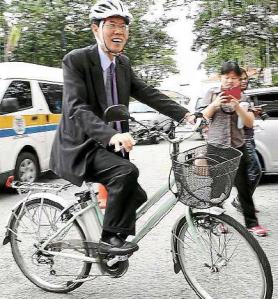BICYCLING WITHIN A COMPREHENSIVE TRANSPORT PLAN,
TO SOLVING TRAFFIC CONGESTION
Dr Lim Mah Hui, Address to MPPP Council Meeting, October 25, 2013
 We must start to draw up a bicycle strategy, policy and plan and this must be integrated into town planning. It should be coherent, not piece-meal and ad hoc. It must be bottom-up and not just top-down, i.e., the bicyclists must be intimately involved in the planning. The plan must include a budget
We must start to draw up a bicycle strategy, policy and plan and this must be integrated into town planning. It should be coherent, not piece-meal and ad hoc. It must be bottom-up and not just top-down, i.e., the bicyclists must be intimately involved in the planning. The plan must include a budget
There are 3 hot issues facing Penang. I call them the 3 Cs – Condos, Cars, Crime representing housing, traffic congestion and crime problems.
The fundamental source of our transport and traffic problem stems from the fact there are too many cars on the road. There will never be enough roads built to accommodate the 10,000 vehicles added every month in Penang. It is well known in transportation studies that the supply of more roads just creates the demand for their usage. The solution lies in better public transport, alternative forms of transportation, and most importantly controlling the use of vehicles. Just building more roads does not solve the problem. Yet this is where I see most of our resources are directed at.
Today, I will just touch on one alternative form of transportation – the bicycle. It is one component of the comprehensive master transport plan in Penang. In human history, the bicycle is the most efficient and cost effective mode of transportation ever invented for moving within a radius of 20 km. Just reflect on these statistics. A car weighs about 1.5 tons and carries one person weighing 70 kg most of the time, i.e. only 15% of its weight; a bicycle weighs 20 kg and can carry 10x or 1000% of its weight.
A bicycle takes up minimum road space; it can go anywhere and does not cause traffic jam. All it needs is a 3-foot lane. Remember the Japanese army conquered Malaya not on armoured tanks but on bicycles. And the Vietnamese beat the French at Dien Bien Phu using bicycles.
A bicycle does not emit any pollution while a car spews tons of CO2 that cause global warming and climate change. Worldwide emission from vehicles is responsible for over 20% of total CO2 emission.
Many cities in the world now have woken to this fact and the more progressive cities are actively promoting bicycling as a form of transport in the cities. The two most progressive cities in the world in this regard are Copenhagen and Amsterdam. Even Singapore is now drafting a comprehensive plan for making bicycle one alternative form of transportation (see Anil Netto’s blog). Penang has taken some baby steps but much more needs to be done.
Copenhagen had its first ten-year bicycle policy from 2002-2012 which made cycling a priority in its city plan. It had 10 KPIs that included – length of bike network, coherence of network, bike modal share of road use, targets for reducing accidents, comfort, speed etc. It had a budget of RM250 million. Bicycle modal share, i.e., percentage of people using bicycle as form of transport within the city, rose from 20% to 50% by 2010. For the larger metropolitan Copenhagen with population of 1.2 million, 21% people use bicycles daily in 2011. The city is now into its second 10-year bicycle plan (2012-2025) which targets 4 core areas – city life, safety, comfort and speed.
People complain that the weather in Malaysia is too hot for cycling. But in Copenhagen the weather is too cold for cycling. The winter average temperature is 32 F i.e. freezing temperature. In Penang, we must plant more trees in the city to provide shade for cyclists and pedestrians. This reduces the temperature by at least 10 degree F.
Georgetown is very suitable for promoting bicycling as an alternative form of transport because it is small only 47 sq mile (i.e. 7 mile by 7 mile) and flat. One can easily cycle within the city limit in 20 minutes. Imagine how traffic will be reduced if more people just cycle around the city during lunchtime instead of driving.
Penang has taken some steps to promote bicycling but mainly for weekend recreation. We now seriously need to promote cycling as one alternative form of transportation for work and commuting. MPPP can be a pioneer in this effort.
The following steps (not exhaustive) should be taken:
- Provide dedicated bicycle lanes to be painted and reflective road studs laid on the roads to improve safety for these users.
- Plant more trees to provide shade
- Provide proper parking space for bicycles
- MPPP work with private entrepreneurs to start bike-renting and/or bike-sharing schemes
We must start to draw up a bicycle strategy, policy and plan and this must be integrated into town planning. It should be coherent, not piece-meal and ad hoc. It must be bottom-up and not just top-down, i.e., the bicyclists must be intimately involved in the planning. The plan must include a budget.
Lastly, I believe in the concept of leading by example. The mayors of London and few other cities use bicycle as a form of transportation. I propose that our leaders at least occasionally cycle to meetings. This will be a major psychological boost for bicycling and provide an example for the public to follow – to show that it’s cool to bike.
# # #
 Dr Lim Mah-Hui is a city councilor for Penang island representing civil society’s participation in the council. He was elected to represent the Penang Forum which is a coalition of over thirty NGOs in Penang. Dr. Lim is an economist and sociologist and has taught in several universities in Malaysia and the U.S. and also worked as finance specialist in international banks. He is a strong advocate of ecological and sustainable form of development for Penang island. For more selections of his writings and speeches visit, http://limmahhui.wordpress.com
Dr Lim Mah-Hui is a city councilor for Penang island representing civil society’s participation in the council. He was elected to represent the Penang Forum which is a coalition of over thirty NGOs in Penang. Dr. Lim is an economist and sociologist and has taught in several universities in Malaysia and the U.S. and also worked as finance specialist in international banks. He is a strong advocate of ecological and sustainable form of development for Penang island. For more selections of his writings and speeches visit, http://limmahhui.wordpress.com# # #
More on the Sustainable Penang: New Mobility project at http://sustainablepenang.wordpress.com

# # #
This is the first in a series of articles which are looking at the challenge of day-to-day transportation cycling in Penang from several different perspectives. The hope is that by bringing these different points of view and contributions together, that the base can be laid for an effective really first-class approach to providing for safe and efficient cycling in Penang.
 Print this article
Print this article



No comments:
Post a Comment
Thank you for your comment. You may wish to check back to the original entry from time to time to see if there are reactions to this. If you have questions, send an email to: editor@worldstreets.org